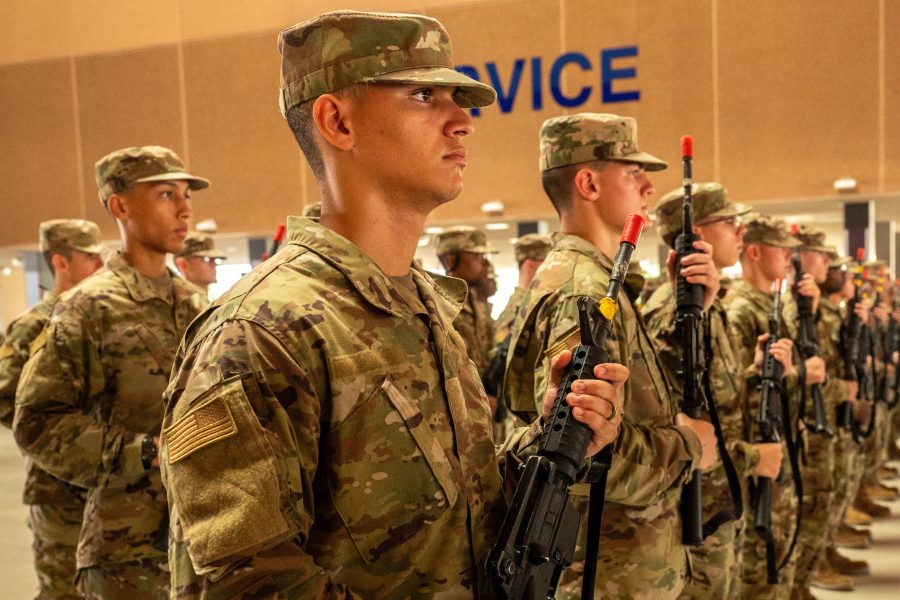Young Air Force and Space Force recruits in Basic Military Training will not be trading in their non-firing M4 carbines for live M4s anytime soon. After leaders previously said they wanted to make the switch, Maj. Gen. Wolfe Davidson said it may not be necessary for Airmen to carry real M4s throughout BMT.
“Right now, we don’t see much benefit to [issuing] live weapons” to recruits to carry through BMT, Davidson, commander of the Second Air Force told Air & Space Forces Magazine. Davidson, who oversees BMT and technical training, is a career special tactics officer who has led air, space and special operations forces during various operations including Enduring Freedom in Afghanistan.
“We will continue to evaluate, but in the near term we are not going to transition to real M4s … for the entirety of basic training,” said Davidson. Last summer, the Air Force began issuing inert M4s, marked by red flash suppressors, to future Airmen and Guardians to carry throughout the majority of boot camp. The carbines have all the parts of a real M4, except for a hammer so they cannot be fired.
“The replicas they have can be fully broken down; fully assembled … just like a standard M4, so they are learning all those aspects of it,” said Davidson, adding that trainees “certainly use real M4s in portions of their training.”
In September, Chief Master Sergeant of the Air Force David Flosi said the goal of the program was to have young Airmen and Guardians carry real M4s to better prepare them for the growing threat of war with a near-peer adversary such as China.
Garrett Exner, a former Marine Corps special operations officer with combat experience in Iraq who is now a fellow with the Hudson Institute, touted the importance of such preparation.
“We’re in an explosion in this time period [of] gray-zone conflict, conflict below the threshold of war with our adversaries, our near-peer competitors. … Clearly we’re butting up against our adversaries in a number of different areas,” said Exner.
“This is actually the best time to get them indoctrinated into a warfighting mindset, when they first come … into basic training,” Exner added.
Marine Corps and Army trainees carry live weapons throughout basic training. Navy recruits do not.
Air Force training officials say issuing inert M4s to trainees has resulted in greater confidence and increased weapons proficiency when they learn to shoot actual M4s in Combined Arms Training and Maintenance, or CATM, in their fourth week of training. Trainees shoot 70 rounds of live ammunition in CATM, which includes zeroing the weapon and qualification.
“We have seen an uptick in marksmanship capabilities and just more confidence, confidence with the weapon,” said Tech Sgt. Anthony Hayes, a master training instructor in BMT who is also a security forces specialist. “When they get to CATM, it’s not the first time they have had the weapon in their hands.”
Currently, trainees secure their inert M4s in lockers when they are in the dormitories, a practice that would have to change with a transition to real M4s, said Davidson, describing the security and logistical challenges that would come with live weapons.
“Obviously there are a lot of logistical challenges to going to real M4s in terms of security and controlling them and all of those types of things,” he said. “There are arms rooms, there are weapons requirements … there are protection requirements, so if you have more than so many weapons, you have to have live weapons guarding them.”
“Then you have to arm your instructors with weapons, so there are lots of challenges from that perspective,” Davidson added.
The Air Force first began requiring trainees to carry inert M4s from 2005 to 2012 before reviving the program last July, said Chief Master Sgt. Whitfield Jack, the senior noncommissioned officer for the 737th Training Group.
Jack, who was a staff sergeant and a BMT instructor during the first iteration of the program, said he has seen how it improves the level of quality and professionalism among trainees.
“We are in the profession of arms,” Jack said. “I understand we are not Soldiers and we are not Marines, but at the end of the day, we are in the profession of arms. So for our Airmen and Guardians to familiarize themselves with a weapon and carry it and use it, I think is absolutely beneficial. And I’ve seen it. I’ve seen the mindset shift as they touch and feel and know what this weapon is about.”
